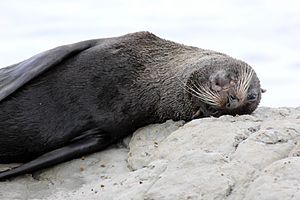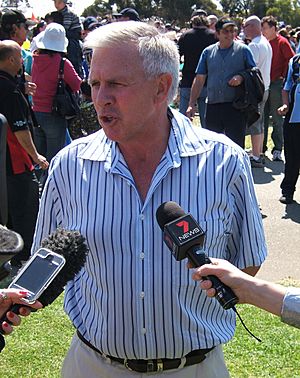Seal culling in South Australia facts for kids
Seal culling in South Australia is a topic that came up in 2015. People discussed it because a type of seal, called the Arctocephalus forsteri or long-nosed fur seal (also known as the New Zealand fur seal), was seen more often near fishing areas.
Long ago, in the 1800s, both fur seals and Australian sea lions were hunted for their skins. Later, in the 1900s, seals were sometimes killed because people thought they were taking fish that fishermen wanted. Today, killing seals is against the law in South Australia. However, people still talk about whether it should be allowed.
All seals and sea lions in South Australia are fully protected by a law called the National Parks and Wildlife Act 1972. In 2016, there were about 100,000 long-nosed fur seals living in South Australian waters.
Contents
History of Seals and People
Even though it's called the New Zealand fur seal, the Arctocephalus forsteri is a native animal to South Australia. To avoid confusion, people are now using the name long-nosed fur seal more often.
In the early 1800s, many of these seals were hunted. Seal hunting continued in some areas, like Gulf St. Vincent, even in the 1880s.
South Australia became an official colony in 1836. Because of this, we don't have records of how many seals lived there before hunting started. Over the last 100 years, the seal population has slowly grown back. This growth has led to more interactions with the fishing industry.
Killing seals in South Australian waters continued into the 1900s. People believed seals were competing with fishermen for fish.
In 1954, a politician named W. W. Jenkins suggested that people should be allowed to hunt seals to control their numbers. A fisherman named A. W. Lundstrom said that before dams were built across the River Murray (between 1935 and 1940), seals were often seen near the town of Goolwa.
Lundstrom, who was the head of the Southern Fishermen's Association, wrote that seals were a problem for fishing, just like rabbits, dingoes, or kangaroos can be for farmers. At that time, three fishermen near Victor Harbor had permission to shoot seals if they bothered their nets. One of them, Mr A. J. Jenkins, wanted an "open season" on seals. He wanted their safe places on the islands to be removed so seals could be killed at their breeding grounds.
An article claimed that seals ate up to 40 pounds (about 18 kg) of fish every day. But A. Keith Minchin, who ran a Koala Farm, said this was a huge exaggeration. He wrote that even a large seal would eat less than 12 pounds (about 5.4 kg) of fish daily.
Fishermen believe that seals are taking fish that they want to catch. They have also reported damage to their fishing nets, which they say was caused by fur seals. People who raise Southern bluefin tuna in sea pens have also reported losing fish. These problems have been reported in areas like Kangaroo Island, the Lower lakes and Coorong, and southern Spencer Gulf.
What the Government Says
In 2012, a spokesperson for the Environment Department of the Government of South Australia said that the government does not support killing, sterilizing, or moving long-nosed fur seals. They explained that trying to control seal numbers this way in other places has been expensive and hasn't worked well. They also said that if a few seals were moved, new ones would likely come in.
In April 2016, South Australia's environment minister, Ian Hunter, repeated the government's view. He said that the best scientific information showed that a seal cull "would not work." He told a newspaper that the government was instead trying to find ways to reduce problems caused by seals. This included testing different fishing nets and using underwater "cracker" deterrents to scare seals away.
All seals and sea lions are protected in South Australian waters. They are listed as marine mammals under the National Parks and Wildlife Act 1972. They are also protected as a marine species under the EPBC Act 1999. This second law means they are protected in even more areas, including waters and lands controlled by the Australian government.
Why Some People Want Seals Culled
Fishermen and people who raise fish in sea pens are the strongest supporters of culling seals in South Australian waters. They say that their businesses have suffered because the seal population has grown back. Other people who support culling include politicians from the Liberal Party, a newspaper writer named Nicolle Flint, and a person who runs penguin tours on Kangaroo Island.
John Ayliffe, who owns the Kangaroo Island Penguin Centre, wants fur seals to be culled on Kangaroo Island. He believes that seals have harmed the little penguin colonies there, which then affects his business.
Some politicians who have supported starting a seal cull include Liberal Party members Adrian Pederick, Michael Pengilly, and Jamie Briggs.
Why Some People Don't Want Seals Culled
Dr Peter Shaughnessy from the South Australian Museum said that killing seals in South Australia would be a bad idea. Groups that work for animal rights, like Animals Australia and Seals of Nam, are against culling. Both groups have started petitions to encourage people to show they are against any future seal cull. Australian Greens politician Tammy Franks has also spoken out against culling, along with the Humane Society International.
While Family First politician Robert Brokenshire has criticized the government for not doing enough, he is also worried about how seal culling could harm South Australia's reputation and tourism. He told the ABC: "Some people have called for culling, but the truth is we can't do that. It would just damage our economy, it would ruin our tourism."
Seal Culling in Other Australian States
Kyri Toumazos, a spokesperson for the SA Shark Industry, suggested that Tasmania has a system for allowing seal culling. However, the Tasmanian government says that all seals in Tasmanian waters are protected.
When asked if seals threaten fishing, the Tasmanian government stated: "Some fishermen complain about seals, saying they take all their fish. Sometimes fishermen suggest that seals should be culled to increase fish stocks. However, looking closely at how seals and fish interact in the whole environment suggests that removing seals might actually be bad for fish stocks, not good. If you remove a top predator, the whole system could be at risk of collapsing."




